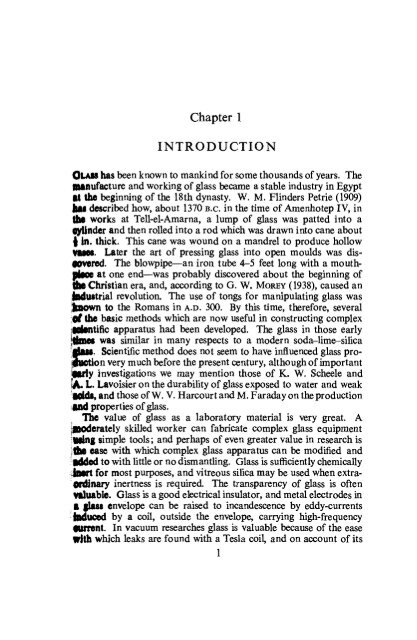Laboratory Glass-Working for Scientists - Sciencemadness Dot Org
Laboratory Glass-Working for Scientists - Sciencemadness Dot Org
Laboratory Glass-Working for Scientists - Sciencemadness Dot Org
You also want an ePaper? Increase the reach of your titles
YUMPU automatically turns print PDFs into web optimized ePapers that Google loves.
Chapter 1<br />
INTRODUCTION<br />
GLASS has been known to mankind <strong>for</strong> some thousands of years. The<br />
manufacture and working of glass became a stable industry in Egypt<br />
it the beginning of the 18th dynasty. W. M. Flinders Petrie (1909)<br />
hfti described how, about 1370 B.C. in the time of Amenhotep IV, in<br />
Die works at Tell-el-Amarna, a lump of glass was patted into a<br />
Cylinder and then rolled into a rod which was drawn into cane about<br />
| In, thick. This cane was wound on a mandrel to produce hollow<br />
Later the art of pressing glass into open moulds was dis-<br />
OOvered. The blowpipe—an iron tube 4-5 feet long with a mouthpteoe<br />
at one end—was probably discovered about the beginning of<br />
Christian era, and, according to G. W. MOREY (1938), caused an<br />
Industrial revolution. The use of tongs <strong>for</strong> manipulating glass was<br />
known to the Romans in A.D. 300. By this time, there<strong>for</strong>e, several<br />
Of the basic methods which are now useful in constructing complex<br />
islentific apparatus had been developed. The glass in those early<br />
was similar in many respects to a modern soda-lime-silica<br />
g)tM. Scientific method does not seem to have influenced glass proigttCtion<br />
very much be<strong>for</strong>e the present century, although of important<br />
iarly investigations we may mention those of K. W. Scheele and<br />
A. L. Lavoisier on the durability of glass exposed to water and weak<br />
•dds, and those of W. V. Harcourt and M. Faraday on the production<br />
Alld properties of glass.<br />
The value of glass as a laboratory material is very great. A<br />
oderately skilled worker can fabricate complex glass equipment<br />
Ming simple tools; and perhaps of even greater value in research is<br />
the ease with which complex glass apparatus can be modified and<br />
idded to with little or no dismantling. <strong>Glass</strong> is sufficiently chemically<br />
inert <strong>for</strong> most purposes, and vitreous silica may be used when extra-<br />
Ordinary inertness is required. The transparency of glass is often<br />
Valuable. <strong>Glass</strong> is a good electrical insulator, and metal electrodes in<br />
ft glass envelope can be raised to incandescence by eddy-currents<br />
induced by a coil, outside the envelope, carrying high-frequency<br />
Current. In vacuum researches glass is valuable because of the ease<br />
With which leaks are found with a Tesla coil, and on account of its<br />
1
















